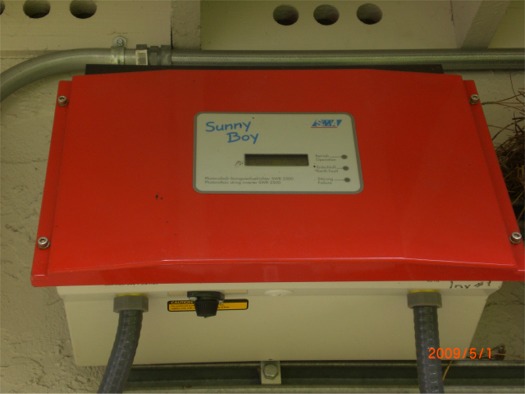The
Grid Tie Inverter
A grid tie inverter is one type of home solar power inverters for grid connected homes. It is the companion to the solar electric panels.
What is a Solar Inverter
The inverter converts DC voltage/current generated by the solar panels to grid compatible AC voltage and frequency (60Hz in the US).
Being in the middle between the solar panel (DC side) and the AC lines, one needs to look carefully to the DC side requirements and to the AC side requirements
Practical Advices
I can give you two practical advices:
- Make sure the inverter is provided with both DC side turn off switch (circuit breaker) and an AC side turn off switch (circuit breaker)
- Make sure the inverter has a “smart” monitor on which you can see how many hours daily and monthly sun activity were registered and how much KWh the system generated daily and monthly. You can also see failure codes to ease repairs
Bellow is a picture of a wall mounted Sunny Boy grid connected solar power inverter

What is difference between on grid and off grid inverter
This is a frequently asked question. The grid tie inverter is synchronized by the grid, the voltage level and the frequency of the grid power is very accurate and very stable. The off-grid inverter must generate the ultra accurate voltage and the ultra stable frequency "from within" and the design therefore is different. Read my page on the off grid pure sine inverter
Grid Tie Solar Inverter Checklist
The DC side of the solar inverter should match the power ratings of the solar panel. The inverter ratings for power handling must be at least as high as the solar panels peak power capability (at maximum sun radiation, at lowest temperature)
On the DC side the input voltage ratings should accommodate a wide range of DC voltages to cover for different solar panels' configurations and to cover the span of solar panel voltages between no load to full load. Usually you’ll find inverters that can accommodate between 100V to 450V DC voltage from the solar panels
Look into efficiency; you don’t want to loose power that were generated by the expensive solar panels on heating up the inverter; the better the efficiency the easier is for the inverter to dissipate generated heat. Good efficiency number is >90%.
Never forget you are dealing with high power electricity – pay heed to all safety procedures as recommended by the vendor. Common sense won’t heart…
Follow up carefully the installation instructions as written in the vendor's manual. This will assure best heat dissipation and longest useful life
Follow up carefully the maintenance instructions
I gave you the guidelines above for 3 reasons
- So you can ask the prospect contractor the right questions (in case you chose to go on a turn key project)
- To get the basic data if you decide to go DIY, before you enter the solar store (on line or off line)
- To ensure long life to the inverter and peace of mind to you
Cost and Life Expectancy
The cost of a grid tie inverter could range between $2,000 to $3,000, it depends on size, manufacturer and features set (switches, smart monitor, protection mechanisms)
Well known US manufacturers are Sunny Boy and Xantrex
The average time between failures can reach 16-20 years because there are no moving parts
click to return from grid tie inverter page to residential solar power page
click to view my Home Page
